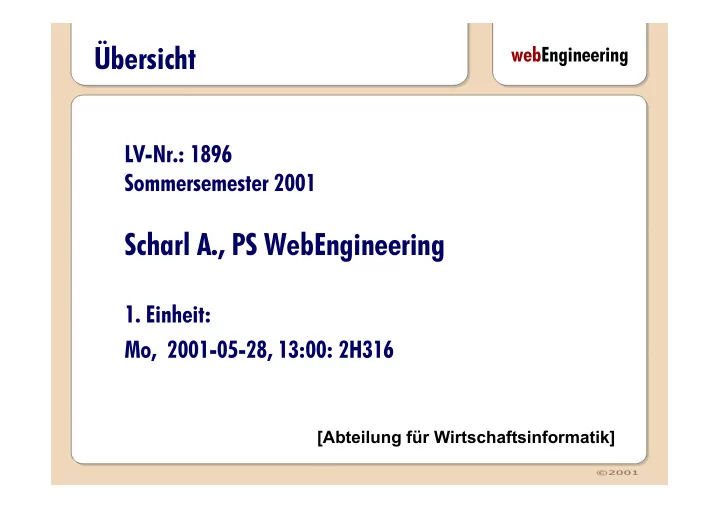

Übersicht webEngineering LV-Nr.: 1896 Sommersemester 2001 Scharl A., PS WebEngineering 1. Einheit: Mo, 2001-05-28, 13:00: 2H316 [Abteilung für Wirtschaftsinformatik]
Termine webEngineering ❚ Zwischenpräsentation: 11. Juni, 13:00 Methodik ❙ Bewertungsfaktoren ❙ Probleme ❙ ❚ Endpräsentation (Ergebnisse): 18. Juni, 13:00 Kurze Vorstellung des Produktes ❙ Bewertung ❙ Funktionalität, Stärken & Schwächen ❘ Strategische Positionierung ❘ Entwicklungstendenzen ❘ ❚ Seminararbeit: 2. Juli (.ppt, .doc) Theorie- und Anwendungsteil ❙ Wissenschaftliche Zitierweise ❙ Formatvorlage ❙
Literatur & Quellen webEngineering ❚ iX, c‘t ❚ IEEE MultiMedia Vol 8 No 1-2 (special issues on Web Engineering) ❙ Grundlagen ❘ Web Engineering: An Introduction ❘ The Essence of Web Engineering ❘ Web Engineering: Creating a Discipline among Disciplines ❙ Web Analysis & Visualization (ReWeb) ❙ Development Methodologies / Web Modeling ❚ http://webdev.wu-wien.ac.at/references.html ❚ http://www.wdvl.com/ ❚ http://www.w3.org/
Electronic Textuality webEngineering
Stage Model of Web Evolution webEngineering
History of Hypertext (1991-95) webEngineering ❚ 1991: Tim Berners-Lee and colleagues at CERN, the European Laboratory for Particle Physics near Geneva, present the specifications for the World Wide Web and introduce the Hypertext Markup Language (HTML 1.0). ❚ 1993: Mosaic is made available by the National Center for Supercomputing Applications (NCSA) and temporarily becomes the most popular browser for accessing the World Wide Web. ❚ 1994: In collaboration with CERN, the World Wide Web Consortium (W3C) is founded at the Massachusetts Institute of Technology. ❚ 1995: HTML 2.0 becomes proposed standard of the Internet Engineering Task Force (IETF). Divided into several working groups, the IETF is an open international community of network designers, operators, vendors, and researchers concerned with the technical evolution of the Internet architecture.
History of Hypertext (1996-99) webEngineering ❚ 1996: Responding to the need for an updated specification, the W3C endorses HTML 3.2 as recommendation, which adds widely deployed features such as tables, applets, or text-flow around images. ❚ 1997: HTML 4.0 is released as W3C recommendation in December 1997. HTML 4.0 supports additional multimedia options, scripting languages, and style sheets. ❚ 1998: The eXtensible Markup Language (XML 1.0), a subset of the Standard Generalized Markup Language (SGML) becomes W3C recommendation. It enables interoperability with both SGML and HTML. ❚ 1999: To allow advanced information retrieval and provide interoperability between applications that exchange machine-understandable information, the W3C issues the Resource Description Framework (RDF) as official recommendation.
Enticklungstendenzen webEngineering ❚ Übergang zu Phasen 2c & 3 ❚ Anbindung zu DB- und Applikationsservern ❚ Integration ❙ Unternehmen (z.B. Macromedia / Allaire) ❙ Werkzeuge (z.B. Frontpage 2002) ❚ Visualisierung ❚ Semantic Web ❚ Peer-to-Peer Applikationen
The Semantic Web webEngineering ❚ Navigation & Layout ❙ SGML (Standard Generalized Markup Language) ❙ HTML (Hypertext Markup Language) ❙ DTD (Document Type Definition) ❚ Semantics ❙ XML (eXtensible Markup Language) ❙ XHTML (eXtensible Hypertext Markup Language) ❙ XML Schema ❚ Application ❙ RDF (Resource Description Framework) ❙ Ontologies
Präsentationsthemen webEngineering ❚ Site Management ❙ Adobe GoLive 5.0 ❙ MS Frontpage 2000 / Visual InterDev ❙ Macromedia ❘ Dreamweaver 4.0 ❘ Dreamweaver UltraDev 4 ❘ ColdFusion 4.5 UltraDev 4 Studio ❙ NetObjects Fusion MX
Präsentationsthemen webEngineering ❚ HTML/XML Editoren ❙ Netscape Composer ❙ Macromedia Homesite ❙ SoftQuad XMetaL 2.1, HoTMetaL PRO 6.0 ❚ Log File Analyzers & Visualisierung ❚ Web Promotion Tools ❙ Applications vs. Services ❙ Search Engine Positioning ❙ Site Check
Definitions (2) webEngineering ❚ Syntax refers to the structure of symbols and investigates relationships between linguistic forms – e.g., words or lemmas in sentences. ❚ Semantics is the study of the relationships between linguistic forms and the users of those forms. It tries to uncover the real meaning of symbols – i.e., words if encoded in language. ❚ Pragmatics is the study of contextual meaning concerned with the interpretation of symbols and with the specific circumstances of communicating. It investigates intended meanings, assumptions, purposes and goals, etc.
Combined Log Files webEngineering ❚ User’s IP address (client host), computing platform, and the name and version number of the browser used to make the request (user agent). ❚ HTTP request type (get, post, head) and protocol version. ❚ URLs of the requested file and of the referring document. ❚ Status code indicating the success or failure of the transaction. ❚ Transfer volume (number of bytes transferred). ❚ Exact date and time of access including offset from Greenwich Mean Time (timestamp). ❚ Username (but not the password) that the reader enters to access password-protected documents (authuser field).
Log File Analyzers webEngineering
AddWeb 4.0 (Website Details) webEngineering
AddWeb 4.0 (Submission) webEngineering
Recommend
More recommend